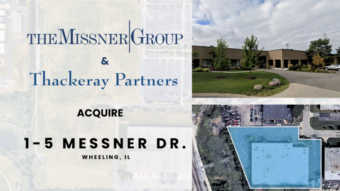For the first half of 2018, industrial remained strong in Chicago. According to Newmark Knight Frank research, the market’s absorption was lower than usual and vacancy increased slightly, but the asset class is still performing well and is projected to keep its record pace for at least the near future.
The modest increase in vacancy—up 10 basis points to 8.1 percent—can partly be attributed to the more than 2 million square feet of vacant spec space that was delivered. The largest of these projects is the 1.2 million-square-foot Rock Creek Logistics Center in Joliet.
Despite the slight rise in vacancy, total availability dropped significantly in the first quarter by 4.8 million square feet since the end of 2017, indicating that some of the newly delivered space is being taken. As a result, rental rates increased again for the quarter, reaching a new record high of $5.38 per square foot.
New development
For new development, the I-80 Corridor again delivered, with over 4.5 million square feet of new construction coming online this quarter, including nearly 3 million square feet in build-to-suits completed by IKEA, Costco and a Wilmington project for General Mills—the largest at a 1.5 million square feet.
Contributing to an increase in the submarket’s vacancy rate last quarter (14.2 percent, up from 11.8 percent) were two new speculative properties delivered that were still vacant at the end of the quarter. Ketone Partners built a 1.2 million-square-foot logistics center in Joliet featuring 36-foot clear height, 118 exterior docks and 367 trailers positions. In Tinley Park, Hillwood completed a 300,000-square-foot spec project this quarter at the Tinley Park Corporate Center.
This was a significant amount of space delivered for the I-80 Corridor, which has seen its inventory expand by almost 20 million square feet in the last five years. The submarket currently has just under 1 million square feet of additional speculative space under construction, which is scheduled to deliver by the end of 2018. This will mean that unless tenants commit to some of these buildings, the vacancy rate will continue to tick up through the end of the year.
The incredible pace of new industrial development in the Chicago market hasn’t met the demand of one need: cold storage facilities. This is mostly due to the fact that construction costs for these properties can be up to four times higher than for general industrial spaces. On average, freezer/cooler construction ranges between $150.00 to $250.00 per square foot, compared with $40.00 to $50.00 per square foot for standard industrial buildings.
It remains challenging for developers to build spec cold storage properties because there are many different specifications that a future tenant may require and the risk of sitting on expensive, unleased property may be untenable. The high construction costs associated with cold storage and a low vacancy rate (5.3 percent, compared to the 8.1 percent vacancy rate for the general industrial average) have driven cold storage rents up to $9.75 per square foot on average, with new, top-tier product pulling in between $12.00 to $14.00 per square foot. With that in mind, the Newmark Knight Frank report suggests that tenants seeking this type of space need to set aside enough time for what could be a lengthy search.
Major transactions
Several large leases and investment sales highlighted the Chicago metro’s transaction velocity during the quarter. In the largest lease of the quarter—and of the year thus far—Kellogg’s company renewed its more than 1 million square feet at 6225 E. Minooka Road for 10 years. The food manufacturer will also expand into an additional 500,000-square-foot building that Prologis is building across the street.
Also this quarter, Home Depot agreed to lease all 588,000 square feet at 525 Northwest Avenue in Northlake. In Aurora, Glanbia signed a lease for 452,000 square feet at 1100 Orchard Gateway. In North Aurora, DART signed for 429,000 square feet at 300 Mitchell Road.
Midway through 2018, the industrial investment sales market showed no signs of decelerating as the Chicago metro has already completed over $1.6 billion in investment sales, a 27.6 percent increase from this time last year. Blackstone recently completed its purchase of the 146-building Canyon Industrial Portfolio from Cabot Industrial Value Fund for $1.8 billion. The portfolio consists of last-mile infill warehouses and distribution facilities in several markets. One of the largest individual property sales in Chicago for the quarter was the sale of Duke Realty’s 212,000 square feet to its user Yusen Logistics. The company, which has been a tenant since construction completed in 2013, purchased the building from Duke for $24.7 million, or $117 per square foot.
Looking forward
Though Chicago’s industrial market has performed just as well through the first half of 2018 as in recent years, it’s difficult to gauge how the sector will perform in the short and long term. The availability of skilled labor, Chicago’s population change and the general demand for industrial product make for a murky prognosis.
As the U.S. and Chicago unemployment rates continue to fall, the skilled labor shortage is becoming more of an issue for industrial businesses. From January to May, Chicago’s unemployment rate fell from 5.6 to 3.3 percent. The construction and manufacturing sectors both saw positive growth in the past 12 months, increasing 3.3 percent and 1.5 percent, respectively.
According to U.S. Bureau of Labor Statistics data, almost a quarter of manufacturing industry employees are at retirement age, which will only exacerbate the situation in upcoming years. Finding people with the right professional and technical competencies is becoming an increasing challenge as companies compete against automation and giants like Amazon.
While this shortage is a serious issue, it has not yet stopped economic growth. Just this quarter, Wieland Metals Inc. announced a $25 million expansion to its 220,000-square-foot facility in Wheeling, a move that would create 65 new manufacturing jobs.
Chicago has been hemorrhaging residents at a pace far quicker than other major markets. However, one growing demographic is households earning more than $100,000 a year and headed by a person under the age of 45; households making at least $200,000 a year grew even faster.
These are important factors for companies looking to move or expand in Chicago because they indicate a talented and educated workforce. These demographics are good for the industrial sector as well, as these households are high-volume users of e-commerce, leading to increased demand for last-mile facilities. While Chicago’s 65 percent increase among these demographics is impressive, it nevertheless lags behind that of many other cities, including Denver, Houston and San Francisco.
Even though labor shortage remains an issue facing the manufacturing and distribution industries and Chicago continues to suffer population losses, the industrial market will continue to see demand for high quality, well-located space in the short term. In fact, with the investment sales market outperforming where it was at this time in 2017, Chicago could have another banner year. Long-term, investors and developers should be wary that the market may be nearing an end to its record-breaking pace.



